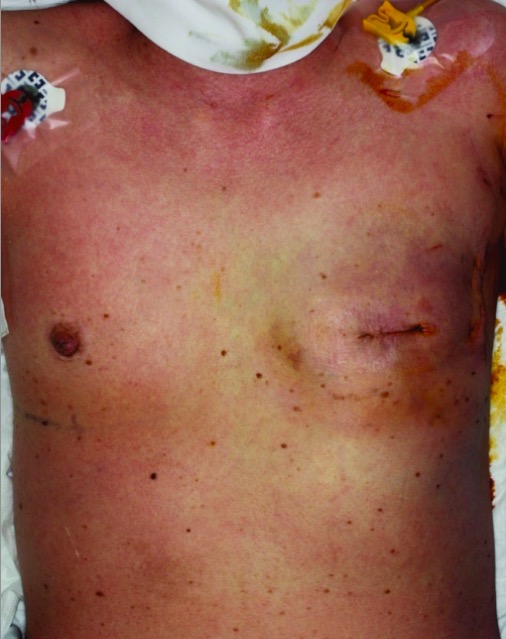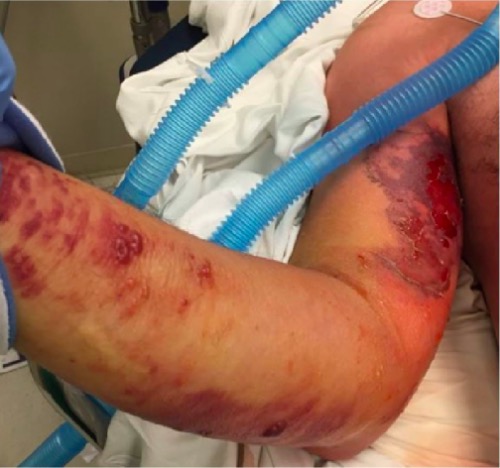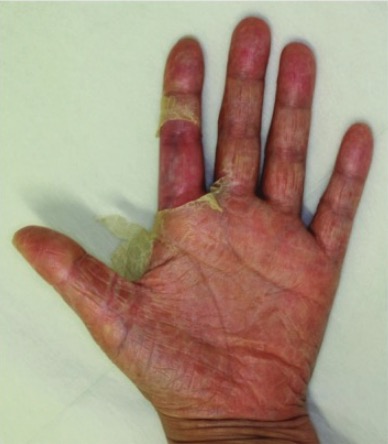Toxic shock Shock Shock is a life-threatening condition associated with impaired circulation that results in tissue hypoxia. The different types of shock are based on the underlying cause: distributive (↑ cardiac output (CO), ↓ systemic vascular resistance (SVR)), cardiogenic (↓ CO, ↑ SVR), hypovolemic (↓ CO, ↑ SVR), obstructive (↓ CO), and mixed. Types of Shock syndrome (TSS) is an acute, multi-systemic disease caused by the toxin-producing bacteria Bacteria Bacteria are prokaryotic single-celled microorganisms that are metabolically active and divide by binary fission. Some of these organisms play a significant role in the pathogenesis of diseases. Bacteriology, Staphylococcus aureus Staphylococcus aureus Potentially pathogenic bacteria found in nasal membranes, skin, hair follicles, and perineum of warm-blooded animals. They may cause a wide range of infections and intoxications. Brain Abscess and Streptococcus Streptococcus Streptococcus is one of the two medically important genera of gram-positive cocci, the other being Staphylococcus. Streptococci are identified as different species on blood agar on the basis of their hemolytic pattern and sensitivity to optochin and bacitracin. There are many pathogenic species of streptococci, including S. pyogenes, S. agalactiae, S. pneumoniae, and the viridans streptococci. Streptococcus pyogenes. Staphylococcal TSS is more common and associated with tampons and nasal packing. Streptococcal TSS is commonly due to invasive group A streptococcal (GAS) infections Infections Invasion of the host organism by microorganisms or their toxins or by parasites that can cause pathological conditions or diseases. Chronic Granulomatous Disease, such as bacteremia Bacteremia The presence of viable bacteria circulating in the blood. Fever, chills, tachycardia, and tachypnea are common acute manifestations of bacteremia. The majority of cases are seen in already hospitalized patients, most of whom have underlying diseases or procedures which render their bloodstreams susceptible to invasion. Glycopeptides and necrotizing fasciitis Necrotizing fasciitis Necrotizing fasciitis is a life-threatening infection that causes rapid destruction and necrosis of the fascia and subcutaneous tissues. Patients may present with significant pain out of proportion to the presenting symptoms and rapidly progressive erythema of the affected area. Necrotizing Fasciitis, and has a higher mortality Mortality All deaths reported in a given population. Measures of Health Status rate. Patients Patients Individuals participating in the health care system for the purpose of receiving therapeutic, diagnostic, or preventive procedures. Clinician–Patient Relationship present with fever Fever Fever is defined as a measured body temperature of at least 38°C (100.4°F). Fever is caused by circulating endogenous and/or exogenous pyrogens that increase levels of prostaglandin E2 in the hypothalamus. Fever is commonly associated with chills, rigors, sweating, and flushing of the skin. Fever, tachycardia Tachycardia Abnormally rapid heartbeat, usually with a heart rate above 100 beats per minute for adults. Tachycardia accompanied by disturbance in the cardiac depolarization (cardiac arrhythmia) is called tachyarrhythmia. Sepsis in Children, hypotension Hypotension Hypotension is defined as low blood pressure, specifically < 90/60 mm Hg, and is most commonly a physiologic response. Hypotension may be mild, serious, or life threatening, depending on the cause. Hypotension, an erythematous rash Rash Rocky Mountain Spotted Fever, and evidence of multi-system organ dysfunction. The diagnosis is based on clinical, laboratory, and culture data. Management involves intravenous fluid (IVF) resuscitation Resuscitation The restoration to life or consciousness of one apparently dead. . Neonatal Respiratory Distress Syndrome, antibiotics, vasopressor Vasopressor Acute Cholangitis support, and identification Identification Defense Mechanisms and management of the potential infectious source.
Last updated: Apr 13, 2025
Toxic shock Shock Shock is a life-threatening condition associated with impaired circulation that results in tissue hypoxia. The different types of shock are based on the underlying cause: distributive (↑ cardiac output (CO), ↓ systemic vascular resistance (SVR)), cardiogenic (↓ CO, ↑ SVR), hypovolemic (↓ CO, ↑ SVR), obstructive (↓ CO), and mixed. Types of Shock syndrome (TSS) is an acute, multi-systemic disease caused by toxin-producing bacteria Bacteria Bacteria are prokaryotic single-celled microorganisms that are metabolically active and divide by binary fission. Some of these organisms play a significant role in the pathogenesis of diseases. Bacteriology:
Risk factors:
Both staphylococcal and streptococcal TSS present similarly, with a rapid onset of signs and symptoms (within hours).

A diffuse, erythematous rash in a patient with staphylococcal TSS
Image: “Case 2 on the first day of onset” by the Department of Plastic Surgery, Kyorin University School of Medicine, Tokyo, Japan. License: CC BY 2.0.
Skin findings in a patient with necrotizing fasciitis and streptococcal TSS
Notice the diffuse edema, ecchymosis, erythema, and bullae.

A desquamating rash on the palms due to staphylococcal TSS
Image: “The hands of case 1” by the Department of Plastic Surgery, Kyorin University School of Medicine, Tokyo, Japan. License: CC BY 2.0, edited by Lecturio.The following criteria are used to define TSS, according to the Centers for Disease Control and Prevention (CDC):
Staphylococcal TSS:
Streptococcal TSS: